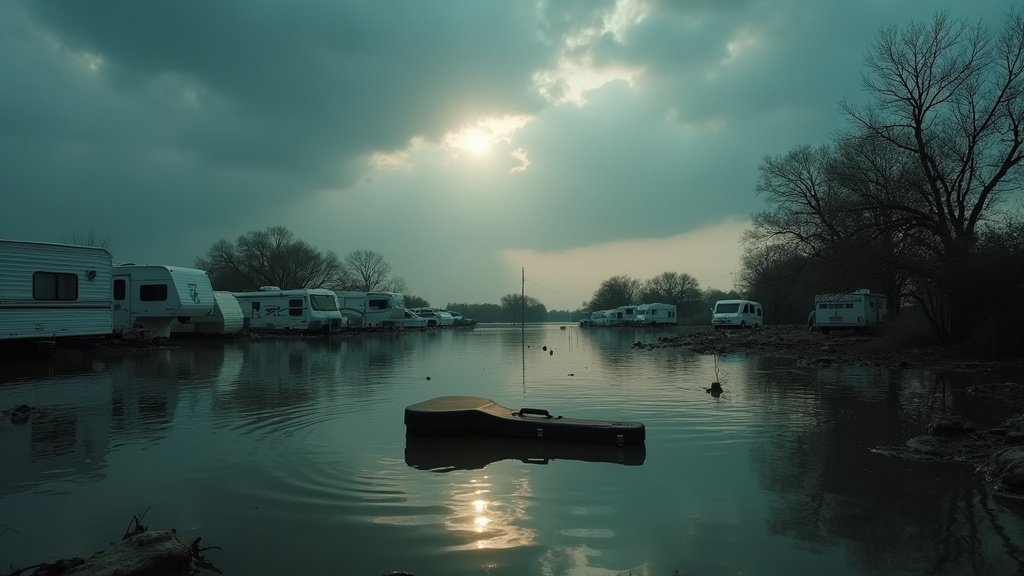Texas Musician Survives Devastating Flood, Calls for Enhanced Community Recovery
By Staff Writer
SAN ANTONIO, TX – In the aftermath of the catastrophic floods that ravaged the Guadalupe River region, Texas musician Julia Hatfield is speaking out about her harrowing experience and the urgent need for strengthened recovery efforts. Hatfield’s RV park, a haven for musicians and artists, was completely destroyed by the rising waters, leaving her and many others displaced and facing immense challenges. This article, originally published on WBUR.org, draws on reporting from the Here & Now Newsroom and was originally published on July 22, 2025.
The Flood’s Fury
The Guadalupe River, known for its scenic beauty and recreational opportunities, transformed into a raging torrent during the recent floods. The unprecedented volume of water surged through the region, leaving a trail of destruction in its wake. RV parks, like Hatfield’s, were particularly vulnerable, becoming targets of the river’s unrelenting force. The devastation was widespread, impacting homes, businesses, and infrastructure across a vast area.
Hatfield’s experience underscores the human cost of these natural disasters. The loss of her RV park, which served as both a home and a workspace, represents more than just a material loss; it signifies the displacement of a creative spirit and the disruption of a close-knit community. The immediate aftermath was marked by chaos and uncertainty as survivors grappled with the immediate needs of survival, including finding shelter, securing food and water, and assessing the extent of the damage.
Community’s Response
Amidst the destruction, stories of resilience and community support have begun to emerge. Neighbors are helping neighbors, sharing resources, and offering assistance in the daunting task of recovery. The outpouring of support, while inspiring, also highlights the limitations of current recovery efforts. Hatfield’s call for more help reflects a broader concern about the adequacy of aid and the need for sustained support to rebuild lives and livelihoods.
The floods have presented a huge challenge to local officials. While relief operations began immediately after the water subsided, the scale of the damage is enormous. Roads and bridges have been damaged, disrupting transportation and supply chains. Homes, businesses, and critical infrastructure need to be repaired and rebuilt, a process that will take considerable time and resources.
The Road to Recovery
The recovery process will be long and difficult, with a significant impact on the affected communities. The economic implications alone are substantial, with the loss of property, income, and business opportunities. The psychological toll on survivors is also significant, with the trauma of the event leaving lasting scars. It’s vital to acknowledge and address these emotional and psychological challenges.
The immediate focus will be on providing essential services, including shelter, food, and medical care. This will be followed by the critical task of assessing the damage and developing a long-term recovery plan. This plan must include measures to rebuild infrastructure, restore economic activity, and address the social and emotional needs of the community.
Calls for Enhanced Aid
Hatfield’s plea for more help highlights a crucial need for governments and aid organizations to enhance support for flood victims. This means not just providing immediate assistance, but also ensuring that long-term recovery programs are adequately funded and effectively implemented. Such programs should also be designed to be more efficient and less bureaucratic.
Increased funding and support are also vital for rebuilding infrastructure, repairing damaged roads and bridges, and providing housing for those who have lost their homes. It’s also essential to create sustainable and disaster-resilient communities.
Looking Ahead
The recovery effort will require the sustained commitment of individuals, communities, and all levels of government. The stories of those affected, like Julia Hatfield, serve as a constant reminder of the human cost of these disasters. Their voices are critical in guiding recovery efforts.
The aftermath of the floods has provided a valuable opportunity to evaluate and improve disaster preparedness and response strategies. This involves reviewing building codes, improving infrastructure, and enhancing early warning systems. Learning from past mistakes is critical to building more resilient communities. It’s essential to prioritize the long-term well-being of affected communities.
The outpouring of support demonstrates the strength of the human spirit and the importance of community. This disaster has revealed the urgency of planning and providing more financial and logistical assistance to people affected. The recovery of the Guadalupe River region will be a long and challenging journey, but the resilience and determination of those affected will hopefully guide the path toward a brighter future.






